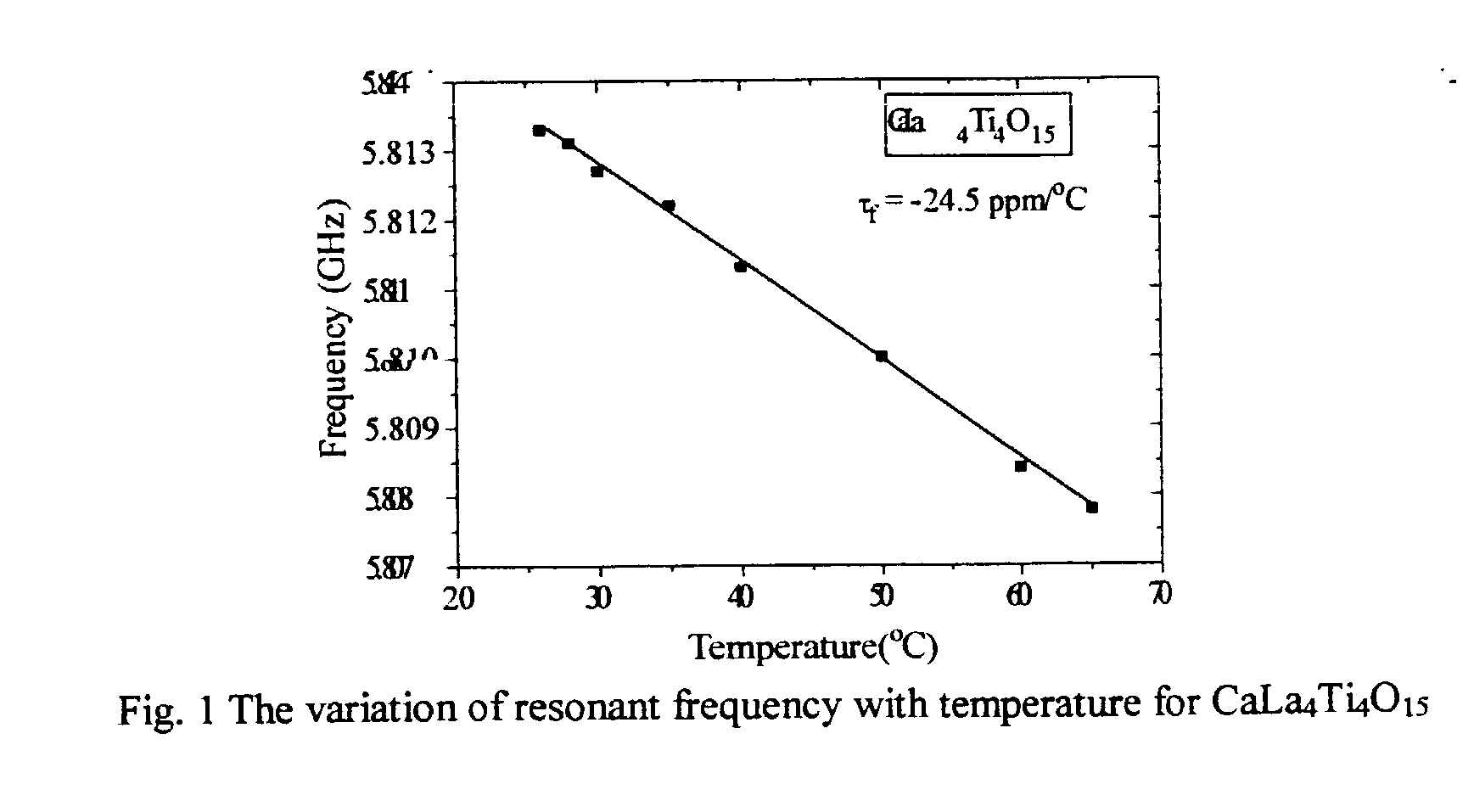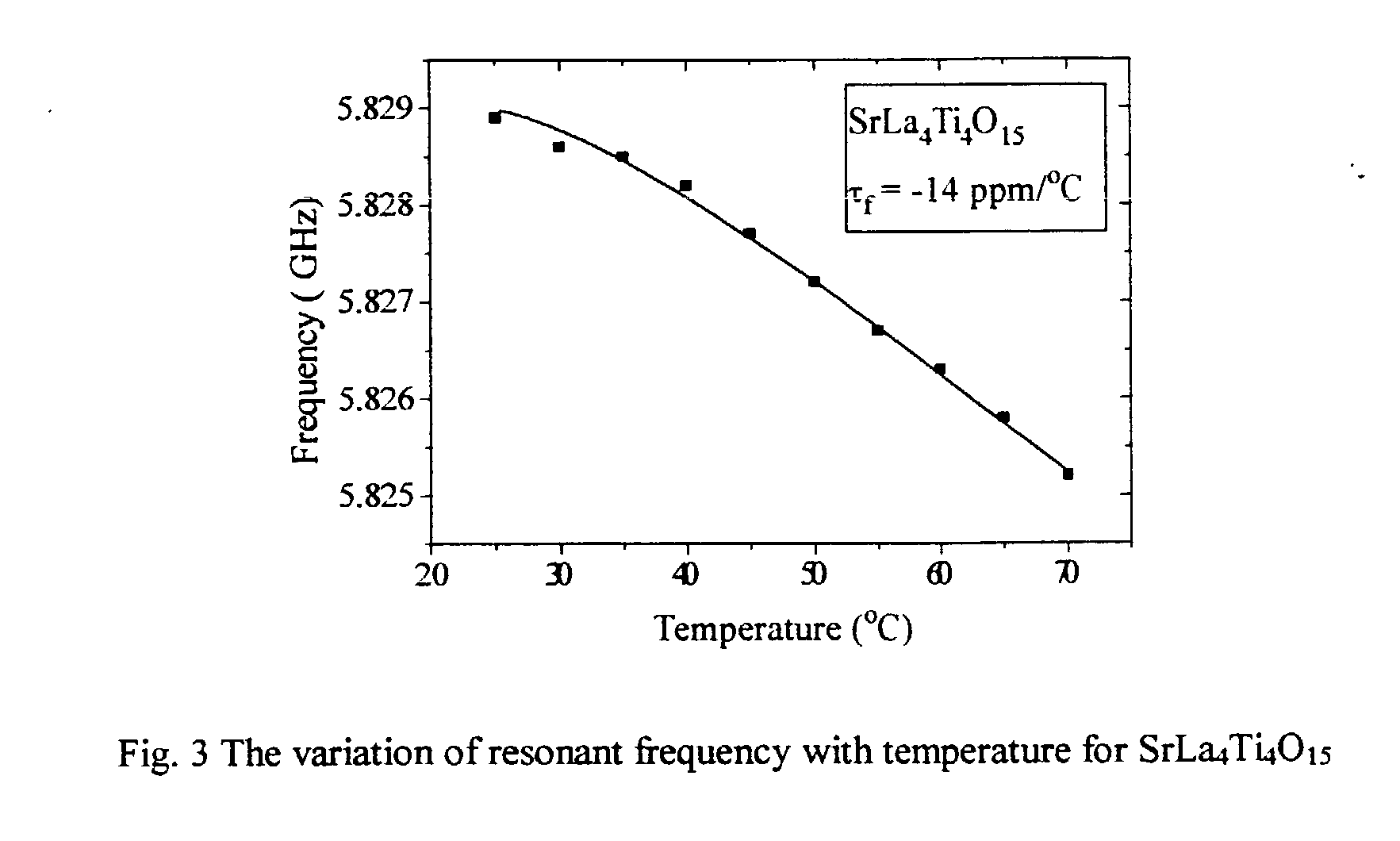Microwave dielectric ceramic composition of the formula xMO-yLa2O3-zTiO2 (M= Sr, Ca; x:y:z = 1:2:4, 2:2:5, 1:2:5 or 1:4:9), method of manufacture thereof and devices comprising the same
a technology of dielectric ceramics and micro-waves, applied in the direction of waveguide devices, fixed capacitor details, fixed capacitors, etc., can solve problems such as unsuitable practical applications, and achieve the effect of avoiding any surface irregularities and maximizing microwave dielectric properties
- Summary
- Abstract
- Description
- Claims
- Application Information
AI Technical Summary
Benefits of technology
Problems solved by technology
Method used
Image
Examples
example 3
[0025] The CaO--La.sub.2O.sub.3--TiO.sub.2 ceramics including the single phase polycrystalline CaLa.sub.4Ti.sub.5O.sub.17 and CaLa.sub.8Ti.sub.9O.sub.31 are prepared by reacting high purity CaCO.sub.3, La.sub.2O.sub.3, TiO.sub.2 in the molar ratios 1:2:5 and 1:4:9 respectively through the solid state ceramic route. The preparation and characterization follows the steps given in the example-1. The firing involves initial calcination at 1200.degree. C. for 4 h, grinding well and again calcining at 1350-1450.degree. C. for different durations, optimizing sintering in the range 1600 to 1675.degree. C. for 2-8 hours. The highly dense single-phase ceramics (>93% of theoretical density) are used for microwave measurements.
3TABLE 3 The microwave dielectric properties of CaLa.sub.4Ti.sub.5O.sub.17 and CaLa.sub.8Ti.sub.9O.sub.31 Sam .tau..sub.f f Material ple .epsilon..sub.r .epsilon..sub.r(corr) ppm / .degree. C. Q GHz CaLa.sub.4Ti.sub.5O.sub.17 A 53.75 54.4 -18 7094 .+-. 300 3.6741 " B 54.11 ...
example 4
[0026] In order to study the performance of the dielectric resonator in actual working environments such as a filter, one dielectric resonator sample of CaLa4Ti4O15 was placed on PTFE substrate inside a copper cavity. The working of the set up was like a band rejection filter at resonant frequency. The microwave power was coupled to the cavity through a copper strip line of 3 mm width and impedance of 50 .OMEGA.. When the dielectric resonator was 25 placed in the vicinity of a microstrip line on the PTFE substrate, magnetic coupling between the resonator and the line was caused. The cavity is rectangular with 50 mm.times.50 mm size with a depth of 30 mm. A metallic disc that can be moved up or down to tune the frequency. The PTFE substrate has a dielectric constant of 2.2 and height of the substrate is 1.8456 mm. The specifications of the sample used are: Dielectric constant=41; Diameter of sample=11.42 mm; Height=4.63 mm; D / L ratio=2.466
[0027] The principal resonant mode is TE.sub....
PUM
| Property | Measurement | Unit |
|---|---|---|
| dielectric constant | aaaaa | aaaaa |
| dielectric constant | aaaaa | aaaaa |
| temperature | aaaaa | aaaaa |
Abstract
Description
Claims
Application Information
 Login to View More
Login to View More - R&D
- Intellectual Property
- Life Sciences
- Materials
- Tech Scout
- Unparalleled Data Quality
- Higher Quality Content
- 60% Fewer Hallucinations
Browse by: Latest US Patents, China's latest patents, Technical Efficacy Thesaurus, Application Domain, Technology Topic, Popular Technical Reports.
© 2025 PatSnap. All rights reserved.Legal|Privacy policy|Modern Slavery Act Transparency Statement|Sitemap|About US| Contact US: help@patsnap.com



